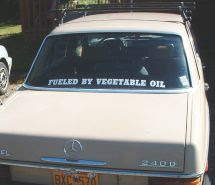 Yep, it's winter in Alaska and I'm getting caught up on my reading.
Yep, it's winter in Alaska and I'm getting caught up on my reading.Although Lyle Estill's book Biodiesel Power is over two years old, it is still a very pertinent and inspiring slice of the American biodiesel movement.
Subtitled "The passion, the people and the politics of the next renewable fuel." I found it a great read that covers not only Estill's journey from backyard brewing to becoming a regional producer, but also the quickly evolving American biodiesel scene.
The other biodiesel history book out there is Biodiesel: Growing a New Energy Economy by Greg Pahl, which is also a pretty good read. It focuses on biodiesel in the global context, how biodiesel was developed and encouraged by universities and governments and how business is running with it.
There's almost no overlap between the two books, and frankly, Biodiesel Power is a bit more entertaining. Maybe it's because it targets folks like me: backyard brewers that give a damn, folks that want to create community, inspire, educate and generally make the world a better place. It's really a book about the grassroots biodiesel movement.
It's the first book I've read that is based around a blog. Estill's Energy Blog chronicles his biofuel journey and he uses past enties as a framework to build his book. (Now if only Girl Mark and Kumar Plocher would package their blog archives into a book form, we'd be set!)
One thing I really appreciate about Estill's book is the way he nods to the founders of the scene, and then moves on. He acknowledges Joshua Tickell's small-batch blender method in his first attempts at making biodiesel, and then gently drops the technique. (I, on the other hand, have railed mightily about the dangers of mixing sparking spinning blenders and poisonous explosive chemicals.) Estill even praises the much maligned FuelMeister, not for it's mediocre fuel-making abilities, but for the fact that it brought larger-scale brewing capabilities to the masses. (Today, I'd go for the BioPro if I needed a pre-built processor.)
Another aspect I like is the way Estill takes on the tougher questions, like sustainability, politics, policy, and the 900 pound gorilla of biodiesel: the National Biodiesel Board. The stress between the small commercial producers and the large agribusinesses is an especially good part.
Biodiesel Power is a history of the American biodiesel movement told through a personal history of veg-fueling. Read it! And yes, you can pre-order his new book: Small is Possible.
Veg On!





